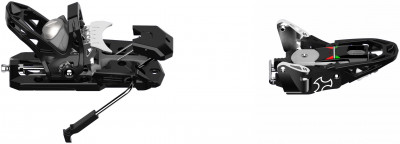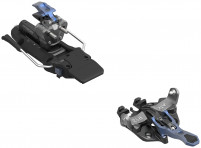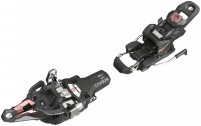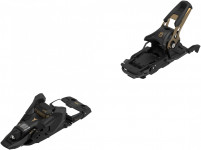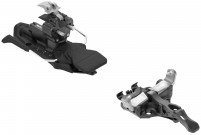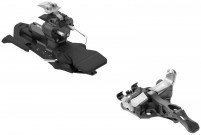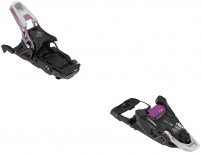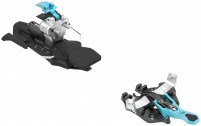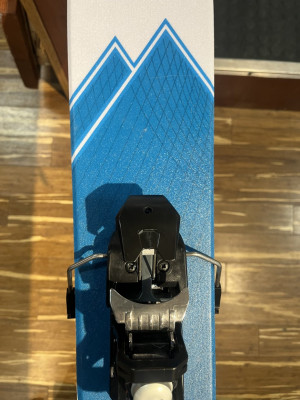Ski Trab TR1 Binding
The Ski Trab TR1 is the epitome of innovation coming from Ski Trab, and that is saying quite a lot for the company with a one-of-a-kind 14-layer ski construction and an utterly unique titanium-based elastic toepiece. Yet here we are, describing another paradigm-shifting product from our ingenious friends in Bormio, Italy. The prodigal son of the TR2, the TR1 (not the TR3, that would be a preposterous name) is designed to offer the same feature set while being compatible with a much wider selection of boots. No longer do you need a specific La Sportiva boot with specific heel inserts to enjoy Ski Trab's most technologically advanced binding to date.
Unlike many bindings in the touring world, the TR1 features a lateral toe release similar to an alpine binding, helping mitigate injuries to the tibia. The toepiece is built with lateral elasticity - whereby the toe wings move synchronously for better retention – as well as an incremental clamping force that allows you to tour with the toe lever unlocked, which provides greater safety when traveling through avalanche terrain. If you find yourself skiing in a "no fall zone," the toe can still be locked out for sections where losing a ski would be catastrophic.
While the toepiece is indisputably brilliant, the heel shines just as much. Whereas the TR2 used a pair of teeth that gripped special inserts on the boot, the TR1 has opted for a full steel shelf that presses the heel lug of the boot down against the binding, exactly like an alpine binding heel. Fore/aft elastic travel on the heel track keeps the release consistent and provides force feedback to your boot as the ski flexes through a turn. Because the boot is fully clamped down against the low-profile brake, the TR1 efficiently and instantaneously transfers energy from the boot to your edges, helping you power the ski through rough terrain. Finally, the two riser levels are easy to engage and the heel can be disengaged from the boot allowing you to switch back to touring mode without exiting the toepiece. If you want a binding that is built as hard as you ski, then you’ve met your match in the Ski Trab TR1.
- Vertical release at the heel and lateral release at the toe are adjustable between 6-13, and release the same way as an alpine binding.
- Primary materials are aerospace-grade Ergal aluminum and steel with minimal plastic for extreme durability.
- Incremental clamping force in the toe wings allows secure touring with the toe unlocked for avalanche safety.
- Lateral elasticity in the toe and fore/aft in the heel makes the release characteristics more predictable and provides more feedback from the ski.
- Low-profile design keeps your boot closer to the ski for better control and responsiveness.
- 21mm of BSL adjustment lets you share this Italian marvel with your friends, or not!
| Specifications | |
|
Weight |
692g [102mm] |
| Weight (pair) | 1384g [102mm] |
|
Boot |
ISO 9523 & 23223 boots, ask for others |
|
Brakes |
88, 102, 112, 120 |
|
BSL |
21mm |
|
Riser |
2 |
|
Vertical |
6-13 |
|
Lateral |
6-13 |
|
Crampon |
Included Option |
| Specs Verified | Yes |
| Design | |
|
|
Ergal, hardened steel |
| Skimo Co Says | |
| Usage | Touring, free touring, resort crossover |
| Notes | Lateral release at the toe |
| Bottom Line | High-performance binding with a focus on safety |
| Compare to other Full-featured Bindings | |
Related Products
Questions & Reviews
Thanks in advance :)
It does elevate the heel slightly in the flat mode. However, it is not as extreme as some other bindings that lack a true flat mode. With a boot that has a decent range of motion, it should not be a problem. But you are correct that it is not completely flat.
Could 120 mm brakes on trab TR1’s flex to
Accommodate a 132 mm waist ski?
You could possibly, but 6mm a side is a lot. You could completely un-bend the brake, then put in a new bend at the edge of the ski; the Trab brakes are pretty burly, but I'm not sure how they'd hold up to that. Sort of an at-your-own-risk deal.
Heel piece with the 120 mm Brahe installed?
I imagine the brake must project out a little ways past the binding baseplate with the 120 mm brake.
As a light weight individual, my recommended DIN is right on the line of 6/6.5. That's all the way bottomed out for this binding - would you recommend that it's still acceptable for me to use it, or should I probably skip over in favor of something that has my DIN more "in the pocket"?
The TR1 gets more shredability points than the Freeraider 15 Evo! The construction is beefier overall, and the alpine heel will increase power transfer and durability for hard landings and aggressive skiing, especially in choppy resort snow. The Freeraider is a very burly tech binding, but it is still a tech binding, whereas the TR1 is more of a hybrid alpine-style binding.
With all that Ski Trab has previously figured out, this binding is tempting as a replacement or even improvement on the Alpine binding. You name "resort crossover". What do your tests show?
On your page https://skimo.co/tech-binding-release-testing, you highlight the likelihood of an ACL tear with an Alpine bind or the likelihood of a tibia fracture with an alpine tech binding. Pick your poison. How does this binding fit into that context?
Considering the "Two dimensional binding release envelope graph", will the graph show a more or less flat line with this binding?
Does this binding do everything very well? Would it be crazy to rid myself of the need to have a pair of resort boots, binders, and skis, install quiver killers and cycle these bindings as needed?
692 grams in the 102 brake, without the mounting screws, which is how we weigh all of our bindings :)
They are most comparable to the Fritsch bindings.
Against the Shift, Lighter and easier to operate, bomber. PS, weight is less then 800g, we will post correct weight when they arrive.
The Kingpin doesn't have any more powerful of a heel hold and just a regular Tech toe. This is where the TR 1 is like the Fritschi. They have a toe with lateral elasticity and release. Unlike it, the toe wings move together laterally as the boot moves laterally. The Fritschi tip over and do not have the constant contact. And the TR 1 is done in polished aluminum, not plastic.
I have skied them and they are powerful. Its unique step in process I nailed on my first try. Those used to Trab bindings will find them easy.
They are the same as the previous TR2 , but don't require a special boot which doomed those. Skimo had tested those and the release worked extremely well.
Earn store credit by writing reviews. Learn more.







